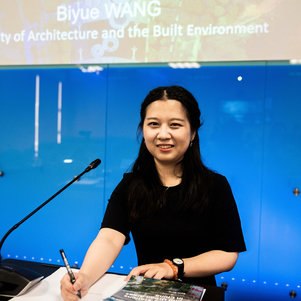China's fast-growing high-speed train network offers opportunities for cities where trains stop. Yet large-scale developments around stations are rarely a success. Without proper urban planning embedding, that will not change, Biyue Wang observes in her doctoral research.
Around the High-Speed Rail (HSR) stations that are springing up like mushrooms in China, entire new cities are planned. A size of ten square kilometers is no exception for the ‘New Towns’. Plenty of room, because the stations are often built miles away from existing cities. ‘And that is not sustainable urban development,’ says Biyue Wang. ‘Their goals are never based on their own situation, but on unrealistic ideas. They all want to become Beijing Central station.’
One thousand stations
China's HSR network has grown rapidly since construction began about a decade ago. There is already more than 45,000 kilometers of track, but by 2030 that length will have doubled. By then the track should connect 34 provincial capitals across the country. In between there will be over a thousand stations.
Potentially, those stations are catalysts for local economic and urban development. This is reason for fierce competition between Chinese cities: each local government wants to lure businesses and new residents with an attractive station area. Local governments are also judged by it: many citizens want a station in their city. Yet the success of HSR areas is low, especially in small towns. That's because they are usually located far from existing cities, offer little or no transfer options and are far too large. ‘The station itself is often closed with barriers,’ Wang says. ‘Sometimes you have to pay people to show the way out.’
Land speculation
The rezoning of large acreages of farmland into building land for the construction of HSR stations has unintended side effects such as land speculation. Local governments, already suffering from high national taxes, have to make high investments, which they later have to recoup. As a result, the emphasis is on real estate development in the "New Towns". It results in fragmented and unsafe areas, with no connection to the surroundings.
In her research, Wang analyzed the planning strategy in HSR station areas of fifteen cities, including Shenzhen, Lanzhou and Yongcheng. She found it to be contrary to the Transit-Oriented Development (TOD). TOD was devised to promote urban development around public transport networks and prevent urban sprawl. Especially in small and medium-sized cities it goes wrong. Chinese planning tactics in these cities also fail to meet the theory for node development, as there are hardly any interchanges.
And that must change, Wang argues. TOD principles such as accessibility and densification around stations must become guiding principles. Moreover, according to her, the Chinese government should start formulating a national policy for spatial development of HSR station areas. In addition, it should give local governments more financial breathing space, because now all the burdens rest on their shoulders.
Cooperate
Local governments themselves should cooperate better with real estate developers and railroad authorities on the location and management of HSR-areas. Moreover, the local population should be given opportunity to participate. More attention should also be paid to the fate of farmers who have been bought out. As it stands, they can neither find housing nor work in the area they used to farm in. ‘But all these changes require thorough reforms of the Chinese institutional system,’ Wang says. ‘Fortunately, it looks like those are coming.’
Recently, the central government did intervene in the plan development around the Yongcheng station area. This modest provincial city wanted to build 18 square kilometers of new town around its future HSR station. ‘The central government reduced that to 8 square kilometers and moved the station to existing urban area,’ Wang says. ‘Very good, that should be an example.’
Published: February 2023

